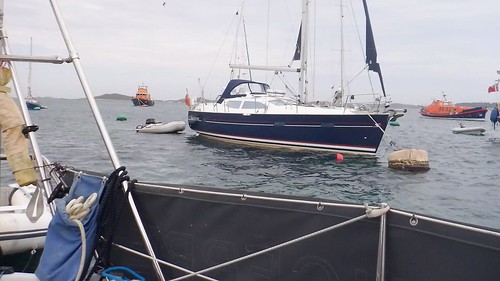Another post stimulated by what I have seen whilst sitting on the boat weather bound - the weather is too miserable to venture ashore and a large cruise liner is potentially decamping 900 passengers onto the islands for a few hours so Hugh Town will be heaving until late afternoon.
This 11.5 metre boat is unstable on her mooring, the video shows her in less than 10 knots of wind, when the wind was stronger she was swinging even more radically and a lot quicker. Note that Sancerre is reasonably stable. Sometimes this happens and there is nothing much you can do about it, perhaps because of a varying wind direction - my time in Plockton earlier in the year was a case in point, or when the boat can't decide to lie to the wind or the tide, but sometimes there is.
Before looking at one reason for this instability and it's cure, a couple of additional points. The rope is sensibly wrapped around a chain link once to reduce the chance of chafe, a running line could easily be worn through in one night or less, the turn significantly reduces this risk but does not totally remove it. Secondly there is, again sensibly, what looks to be a back up line clipped to the chain.
On a permanent mooring the buoy end of the mooring line would normally be attached with a shackle with a thimble spliced into the rope protecting the line from chafe, the problem with a temporary mooring is that it is not really practical to wire the shackle pin and they can come undone. It happened to me in Fowey a few years ago, I had tightened a seriously big galvanised shackle pin as tight as I could without tools and a couple of days later the pin was gone. Fortunately I always have a back up so the boat did not disappear out to sea. A carabiner or proprietary clip of some sort will work but can be expensive and more than one may be required to cope with different sizes of attachment points.
A more flexible and cheaper option is a rope - chain - rope bridle. Lengths of nylon line, either cable laid or platted, is spliced to each end of a length of chain and the bridle adjusted so that the chain runs through the loop on the buoy or as in this case (in St Helen's Pool, Isles of Scilly) through a link in a length of heavy chain. They can be purchased from a rigger or from at least one on line chandler (Jimmy Green) but are easy to make yourself, a 3 strand rope to chain splice is as easy as splices come, and far cheaper.
 |
| Sancerre lying to a rope-chain-rope bridle. Note a safety line going a different route (bow roller and a different link of the chain) to minimise the chance of chafe. The pick up buoy is hung over the pulpit to stop it banging against the hull - very annoying when you are tying to sleep. The bridle is of 8mm chain and 12mm rope, a little light weight for a serious blow or for a permanent mooring but light and easy to set up, I also have one with 16mm rope and 10mm chain which has a break load of over 5 Tonnes. |

No comments:
Post a Comment